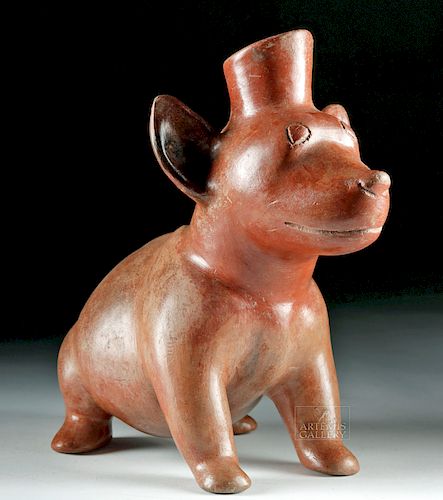Large Colima Redware Seated Dog Vessel
Lot 275
About Seller
Artemis Fine Arts
686 S Taylor Ave, Ste 106
Louisville, CO 80027
United States
Selling antiquities, ancient and ethnographic art online since 1993, Artemis Gallery specializes in Classical Antiquities (Egyptian, Greek, Roman, Near Eastern), Asian, Pre-Columbian, African / Tribal / Oceanographic art. Our extensive inventory includes pottery, stone, metal, wood, glass and textil...Read more
Estimate:
$2,800 - $4,200
Absentee vs Live bid
Two ways to bid:
- Leave a max absentee bid and the platform will bid on your behalf up to your maximum bid during the live auction.
- Bid live during the auction and your bids will be submitted real-time to the auctioneer.
Bid Increments
| Price | Bid Increment |
|---|---|
| $0 | $25 |
| $300 | $50 |
| $1,000 | $100 |
| $2,000 | $250 |
| $5,000 | $500 |
| $10,000 | $1,000 |
| $20,000 | $2,500 |
| $50,000 | $5,000 |
| $100,000 | $10,000 |
| $200,000 | $20,000 |
About Auction
By Artemis Fine Arts
Jan 7, 2020
Set Reminder
2020-01-07 10:00:00
2020-01-07 10:00:00
America/New_York
Bidsquare
Bidsquare : VARIETY AUCTION - Antiquities / Ethnographic
https://www.bidsquare.com/auctions/artemis-gallery/variety-auction---antiquities-ethnographic-4787
Around the world & back in time - be amazed at the treasures you will find. Antiquities from Egypt, Greece, Italy and the Near East, Asian, Pre-Columbian, African / Tribal / Oceanic, Native American, Spanish Colonial, Russian Icons, Fine Art, much more! Artemis Fine Arts info@artemisgallery.com
Around the world & back in time - be amazed at the treasures you will find. Antiquities from Egypt, Greece, Italy and the Near East, Asian, Pre-Columbian, African / Tribal / Oceanic, Native American, Spanish Colonial, Russian Icons, Fine Art, much more! Artemis Fine Arts info@artemisgallery.com
- Lot Description
**Originally Listed At $1500**
Pre-Columbian, West Mexico, Colima, Protoclassic period, ca. 100 BCE to 250 CE. A large and particularly plump dog effigy vessel, finely-molded in lustrous, highly-burnished redware in a seated pose atop four tubular legs. The rotund belly nearly grazes the ground, with a visible spinal crest along the back, and a short tail curling upward from the posterior. His attentive head boasts a minimalist visage of incised eyes, a conical snout with slit-form nostrils, and a slender mouth, with cupped ears and a cylindrical spout defining the latter half. A beautiful and sizable example replete with character and charm! Size: 5.25" W x 9.75" H (13.3 cm x 24.8 cm).
Scholars know of at least two types of Colima dogs, one to be fattened up and ritually sacrificed or eaten and one to serve as a watchdog and healer of the ill. This plump hairless canine known as a Chichi or Escuintla is thought to be related to the Chihuahua or Mexican Hairless also known as the Xoloitzcuintle. The Xolo dog was named for the deity Xolotl, the God of the Underworld, and believed to guide the deceased as they journeyed to the afterlife. Colima vessels such as this one were buried in shaft tombs to protect the deceased and provide sustenance for eternity.
A stylistically-similar, slightly-larger example hammered for $4,800 at Christie's, New York "Fine Pre Columbian Art" auction (sale 1775, November 21, 2006, lot 147): https://www.christies.com/lotfinder/lot/colima-dog-protoclassic-ca-100-bc--4821182-details.aspx?from=searchresults&intObjectID=4821182&sid=a38f51e7-1700-49c7-a11f-420df96656c5
Provenance: ex-private J.G. collection, Las Vegas, Nevada, USA, acquired before 1975
All items legal to buy/sell under U.S. Statute covering cultural patrimony Code 2600, CHAPTER 14, and are guaranteed to be as described or your money back.
A Certificate of Authenticity will accompany all winning bids.
We ship worldwide and handle all shipping in-house for your convenience.
#139737Restoration to one ear with resurfacing and overpainting along break line. Minor abrasions to legs, tail, body, and head, with fading to original pigmentation along body and tail, and light encrustations. Light earthen deposits and manganese blooms throughout.Condition
- Shipping Info
-
All shipping is handled in-house for your convenience. Your invoice from Artemis Gallery will include shipping calculation instructions. If in doubt, please inquire BEFORE bidding for estimated shipping costs for individual items.
-
- Buyer's Premium



 EUR
EUR CAD
CAD AUD
AUD GBP
GBP MXN
MXN HKD
HKD CNY
CNY MYR
MYR SEK
SEK SGD
SGD CHF
CHF THB
THB
















